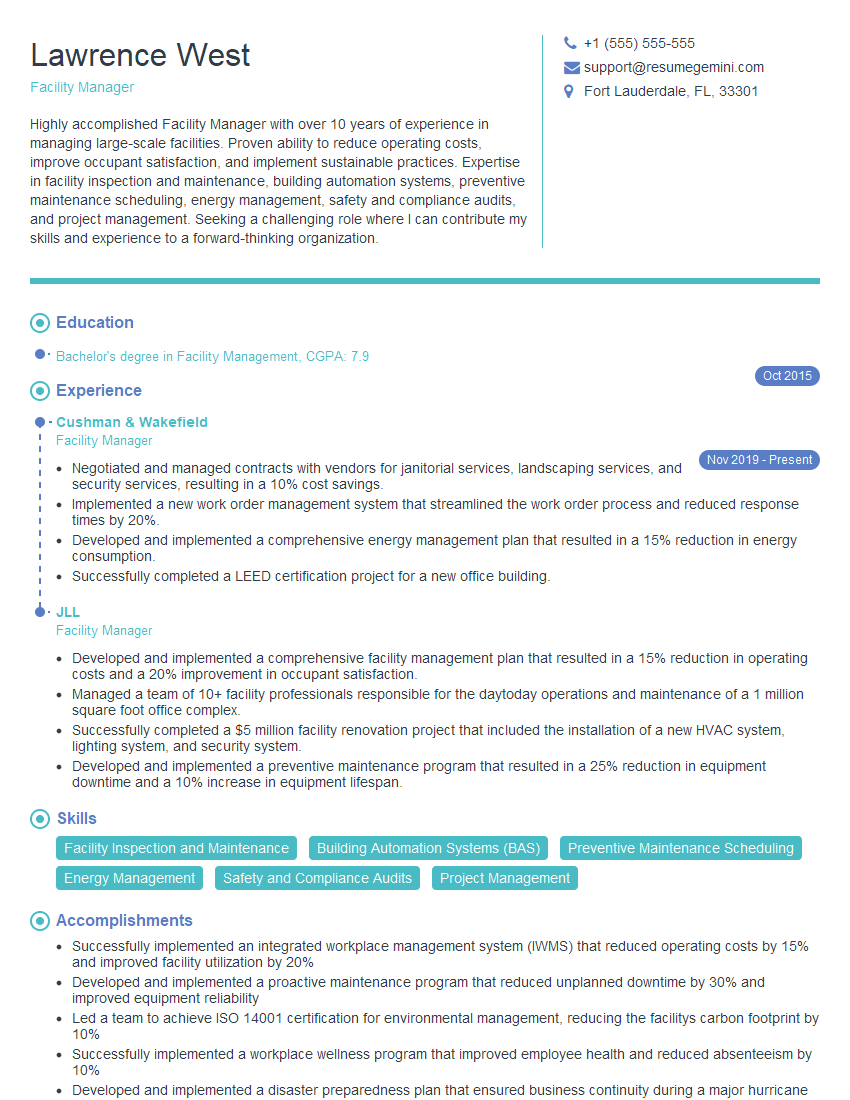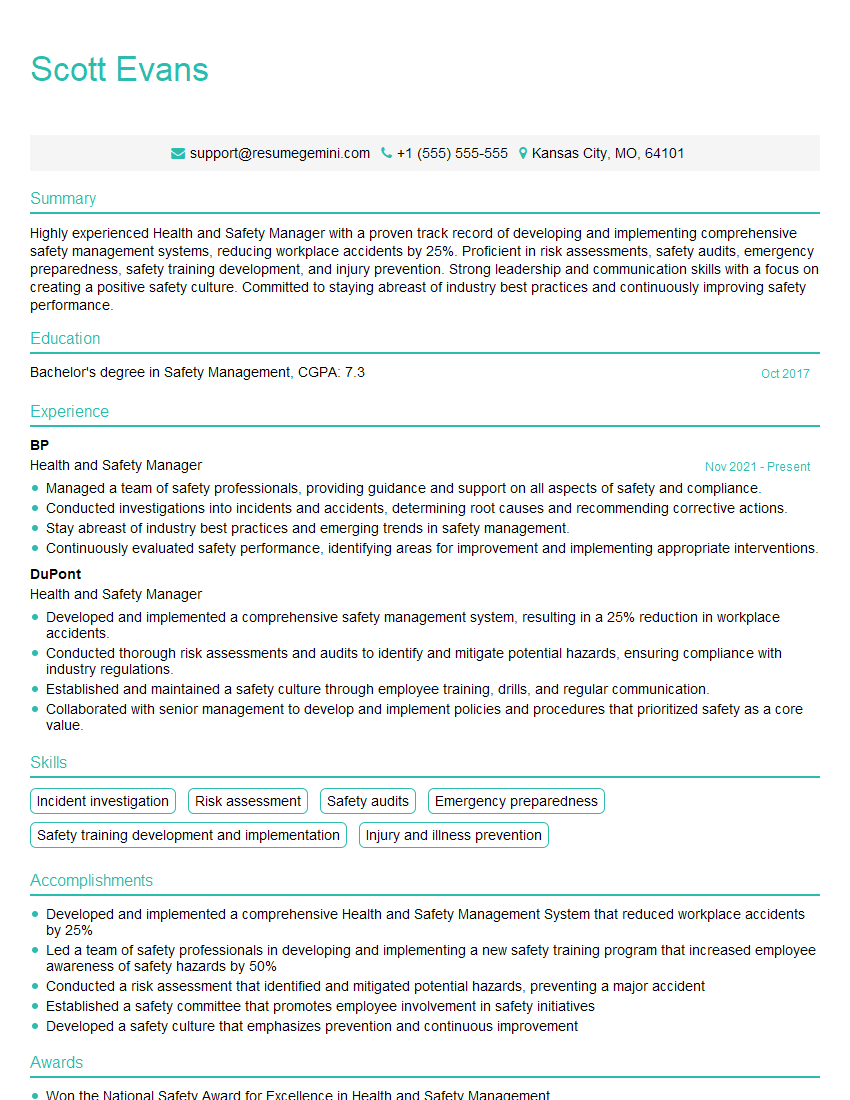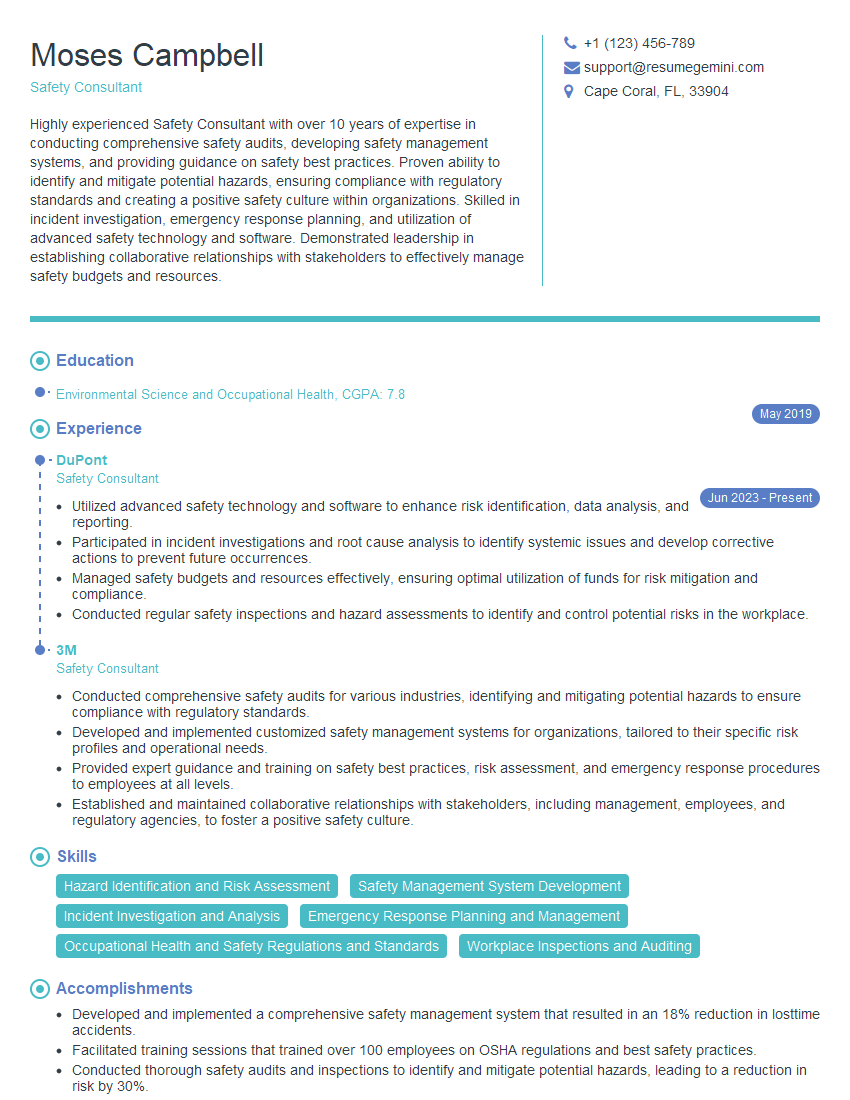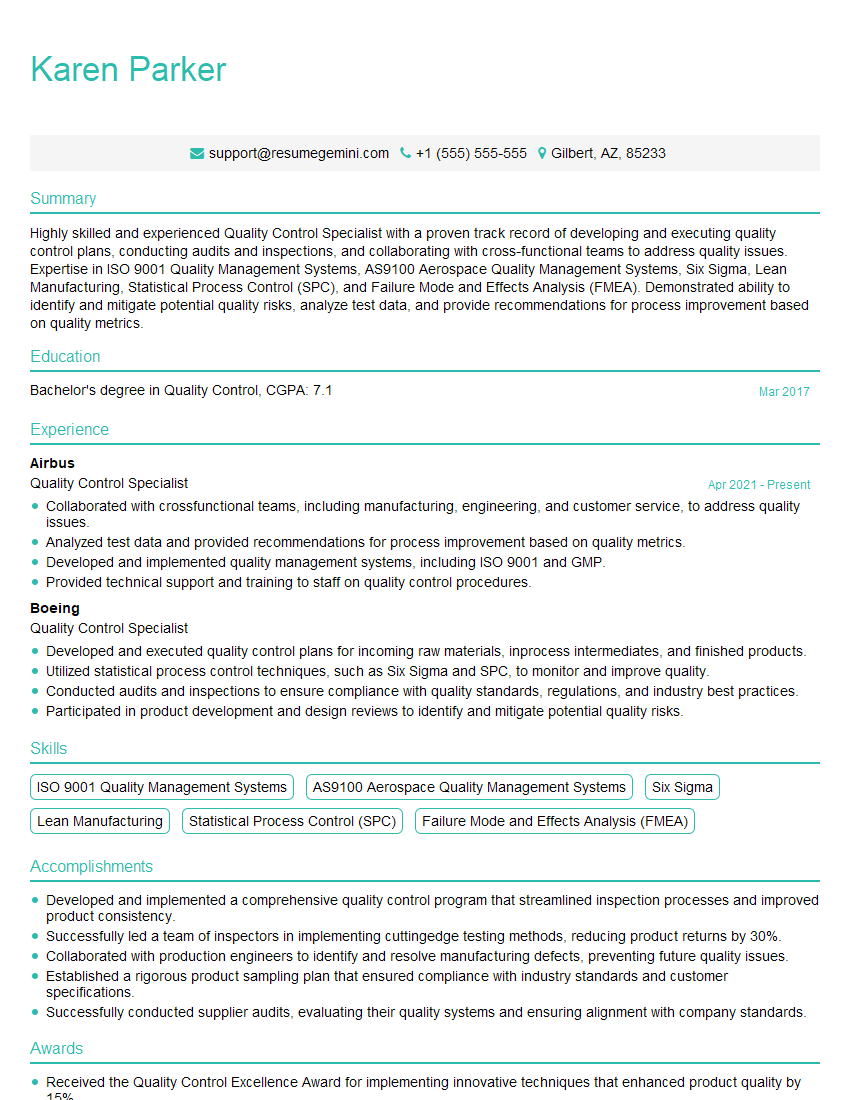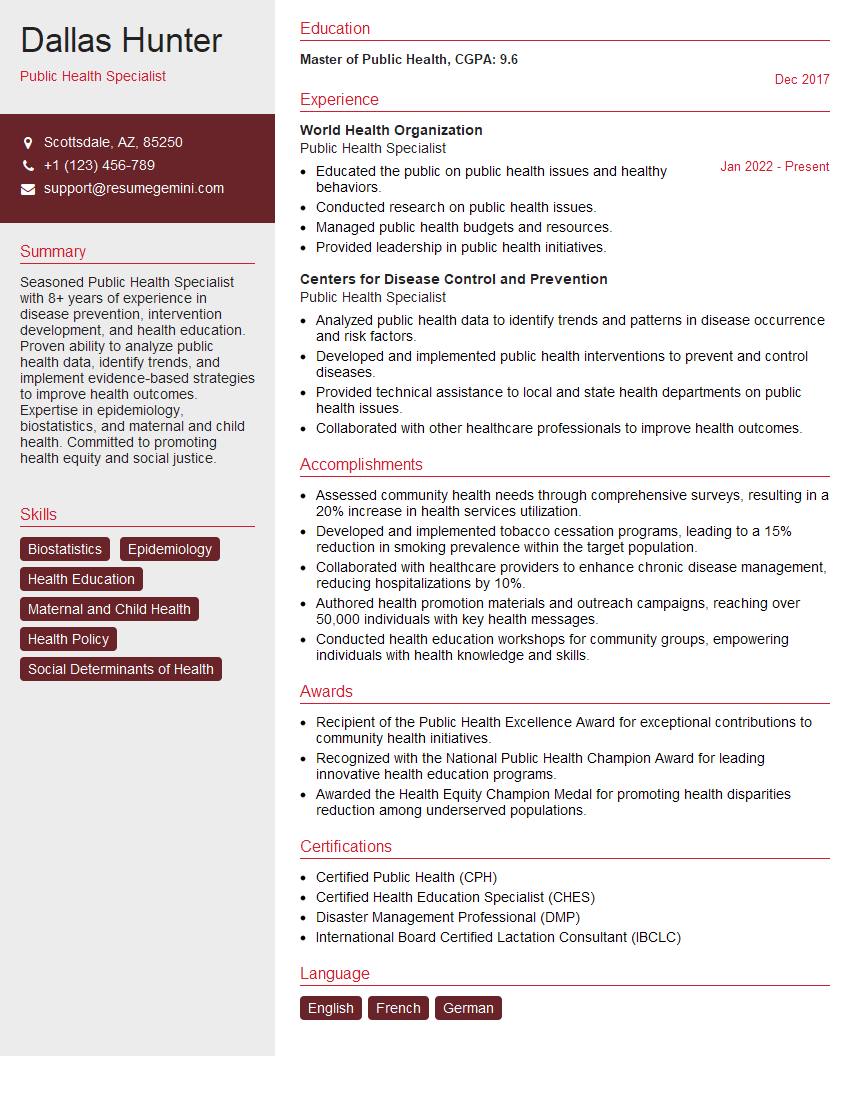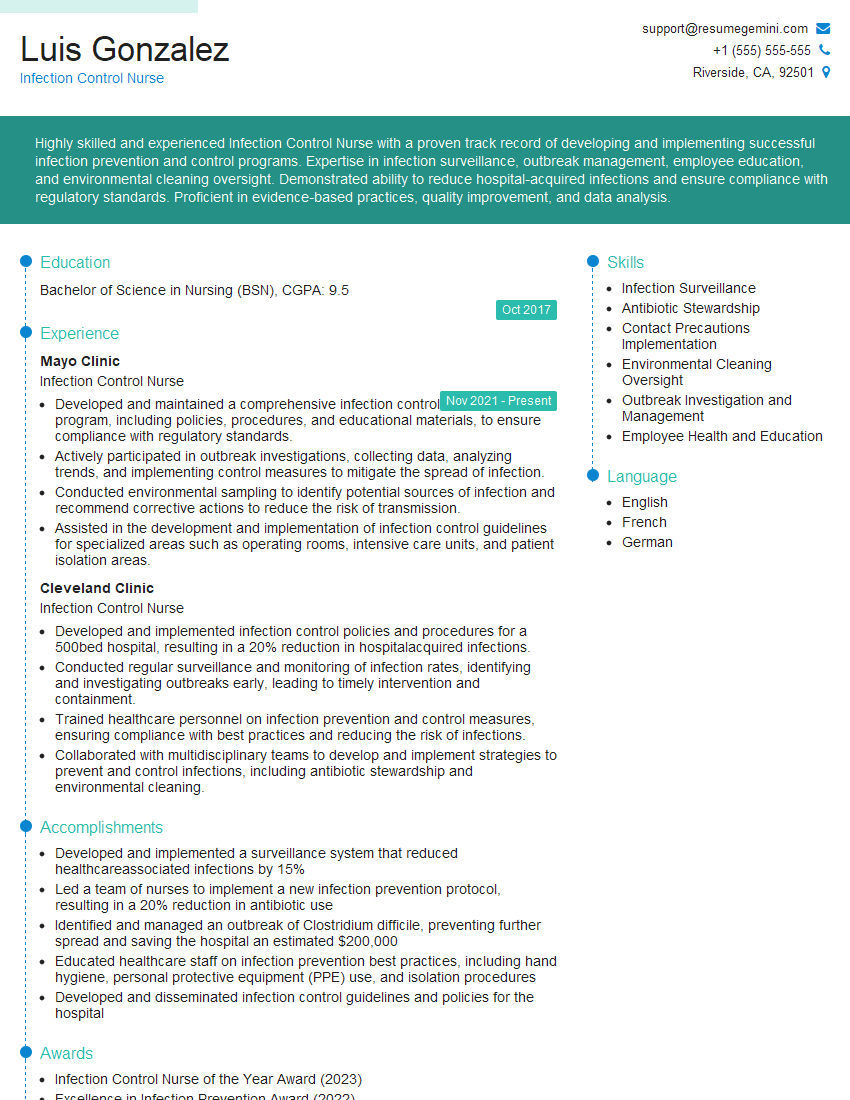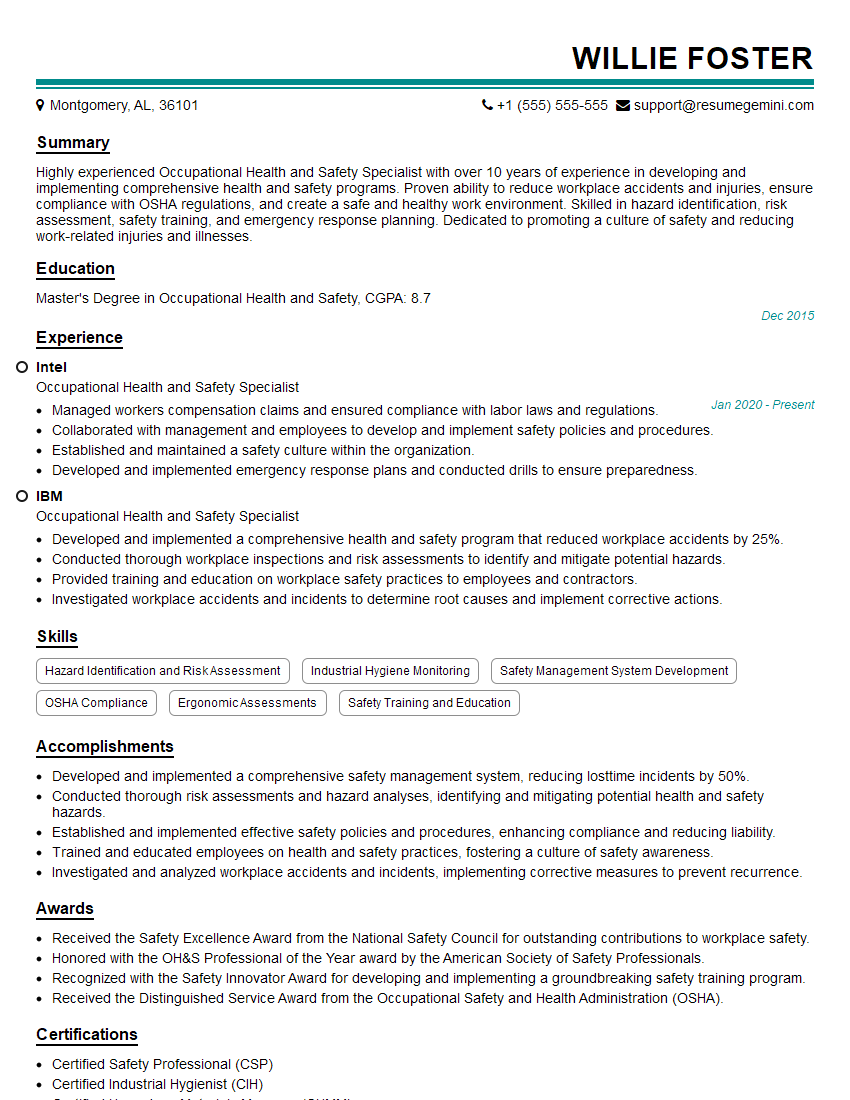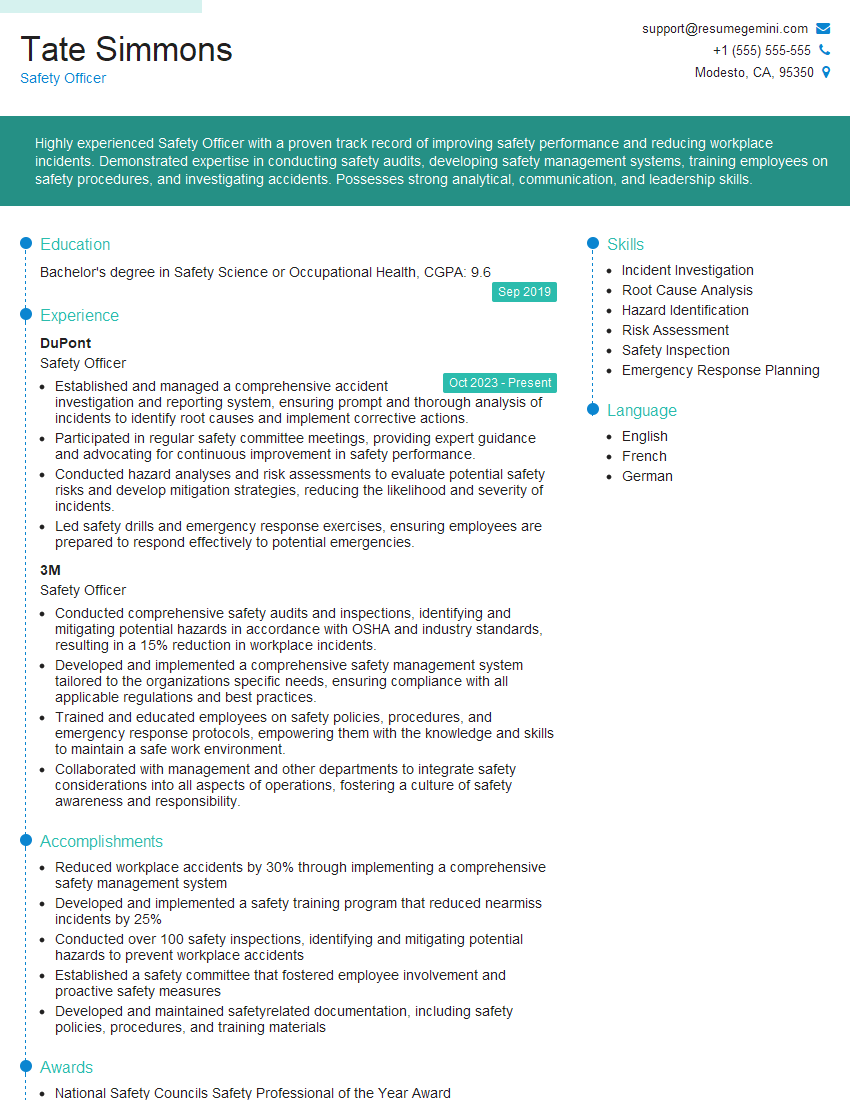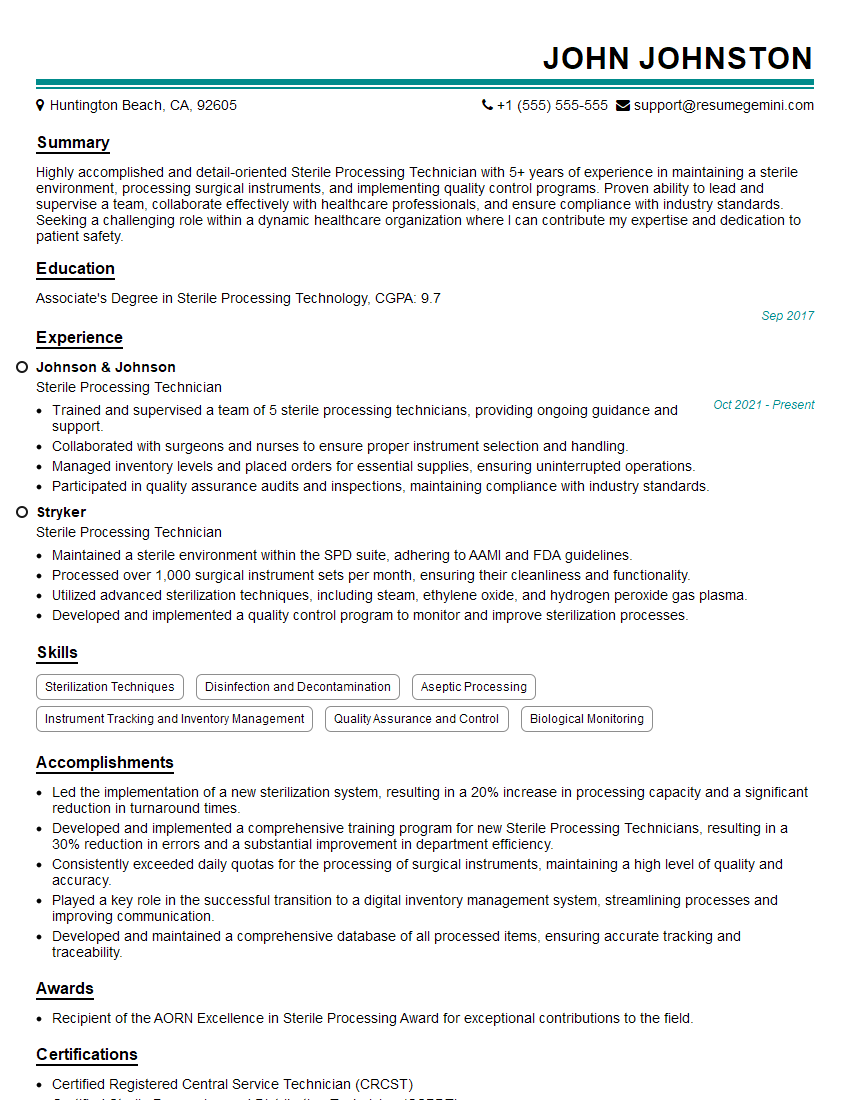Preparation is the key to success in any interview. In this post, we’ll explore crucial Adhering to all safety and sanitation protocols interview questions and equip you with strategies to craft impactful answers. Whether you’re a beginner or a pro, these tips will elevate your preparation.
Questions Asked in Adhering to all safety and sanitation protocols Interview
Q 1. Describe your experience implementing and maintaining sanitation protocols.
Implementing and maintaining sanitation protocols is a multi-faceted process requiring meticulous attention to detail and consistent execution. My experience encompasses developing and enforcing comprehensive sanitation plans, including regular cleaning schedules, staff training, and the procurement and proper use of cleaning agents.
For example, in my previous role at a large-scale food processing facility, I was responsible for overseeing the sanitation of all production areas, equipment, and utensils. This involved creating a detailed sanitation schedule outlining specific cleaning tasks for each area, assigning personnel, and establishing checklists to ensure thoroughness. We utilized a color-coded system for cleaning supplies to prevent cross-contamination and implemented a rigorous monitoring system to track compliance and identify any deviations from the established protocol. We also conducted regular staff training sessions to reinforce the importance of sanitation and ensure proper techniques were employed.
Another crucial aspect was managing chemical inventory and ensuring the safe and effective use of cleaning and sanitizing agents. This involved following all manufacturer instructions, understanding Material Safety Data Sheets (MSDS), and implementing safety protocols to prevent accidental exposure or misuse. We also monitored chemical effectiveness through regular testing, adjusting our approach as needed to maintain optimal sanitation levels.
Q 2. Explain the importance of HACCP principles in food safety.
HACCP, or Hazard Analysis and Critical Control Points, is a preventative food safety system that identifies potential biological, chemical, and physical hazards in food production and implements controls to eliminate or reduce them to safe levels. It’s crucial because it shifts the focus from reactive measures (like addressing contamination after it happens) to proactive prevention, greatly minimizing the risk of foodborne illnesses.
Think of it like building a house. Instead of waiting for the roof to leak and then fixing it, HACCP is about designing the roof to be leak-proof from the start. The principles involve identifying hazards at each step of the food production process, determining critical control points (CCPs) where hazards can be controlled, establishing critical limits for those CCPs, implementing monitoring procedures, corrective actions, verification procedures, and record-keeping.
For instance, in a bakery, a CCP might be the baking temperature. If the temperature drops below a critical limit, the product may not be fully cooked, leading to bacterial growth. HACCP ensures that the temperature is constantly monitored, and corrective actions are taken immediately if the temperature deviates from the set limits. This proactive approach significantly reduces the risk of foodborne illnesses associated with improperly baked goods.
Q 3. What are the key steps in a proper handwashing procedure?
Proper handwashing is the cornerstone of food safety and hygiene. It’s a simple yet powerful method of preventing the spread of pathogens. The key steps are:
- Wet hands with clean, running water (warm or cold).
- Apply soap and lather well, covering all surfaces of hands and fingers.
- Scrub hands vigorously for at least 20 seconds, paying particular attention to the backs of hands, between fingers, and under nails.
- Rinse hands thoroughly under clean, running water.
- Dry hands using a clean towel or air dryer.
Think of it as a mini-car wash for your hands. Each step removes a layer of potential contaminants. It’s not just about cleanliness; it’s about actively removing harmful bacteria and viruses that could easily contaminate food or surfaces.
Q 4. How do you identify and address potential safety hazards in a workplace?
Identifying and addressing potential safety hazards requires a proactive and systematic approach. This involves regular workplace inspections, hazard assessments, and employee training. I employ a risk-based approach, prioritizing hazards based on their likelihood and potential severity.
For example, I might use a checklist during inspections to look for things like spills, damaged equipment, blocked walkways, or improper storage of chemicals. If a hazard is identified, I follow a standard procedure for addressing it – which might include immediate remediation, implementing safeguards, or reporting the issue to management for appropriate action. This could involve fixing a faulty machine, providing employees with proper personal protective equipment (PPE), or re-organizing the workspace to reduce clutter and improve flow.
Beyond physical inspections, I encourage a culture of safety by promoting open communication and employee participation in identifying and reporting hazards. Employees are often the first to notice potential problems, so their input is invaluable. Regular safety training also plays a significant role in equipping employees with the knowledge and skills to identify and avoid hazards, and to respond appropriately in case of incidents.
Q 5. Describe your experience conducting safety inspections.
Conducting safety inspections requires a methodical and thorough approach. My inspections typically involve a visual assessment of the facility, coupled with checking for compliance with established safety protocols and regulations. I use checklists and documented procedures to ensure consistency and completeness.
For example, in a food processing plant, my inspections would include evaluating the cleanliness and sanitation of equipment and work areas, checking the proper use and storage of chemicals, inspecting emergency equipment (fire extinguishers, first-aid kits), and observing employee practices to ensure adherence to safety procedures (such as proper use of PPE). I document all findings, including any identified hazards and corrective actions taken or required. These inspection reports are shared with management to facilitate the implementation of corrective measures and to track improvements in workplace safety.
Beyond the visual aspects, I also look for patterns or trends in reported incidents or near misses. This can help pinpoint areas requiring additional attention or improvements to existing protocols. It’s a continuous improvement process, using data from inspections to proactively address potential safety issues before they become actual incidents.
Q 6. What is your understanding of OSHA regulations (or relevant regional regulations)?
My understanding of OSHA (Occupational Safety and Health Administration) regulations is comprehensive. I’m familiar with the General Duty Clause, which requires employers to provide a workplace free from recognized hazards, as well as specific standards related to various aspects of workplace safety and health, including hazard communication, personal protective equipment, machine guarding, and emergency action plans.
I know that OSHA standards are constantly evolving, and staying current with updates and revisions is critical. I regularly review relevant OSHA publications and participate in continuing education programs to ensure my knowledge remains up-to-date. My experience includes implementing and maintaining compliance programs, ensuring appropriate documentation, and conducting training to educate employees about their rights and responsibilities under OSHA.
Understanding OSHA regulations is not simply about compliance; it’s about creating a safe and healthy work environment that protects employees from injury and illness. This directly impacts productivity, morale, and the overall success of the organization.
Q 7. Explain the difference between sanitizing and disinfecting.
Sanitizing and disinfecting are both crucial for maintaining hygiene, but they achieve different goals. Sanitizing reduces the number of microorganisms to a safe level, while disinfecting kills or inactivates a significant portion of microorganisms, including harmful pathogens.
Think of it like this: sanitizing is like cleaning up a messy room – reducing the overall clutter, making it presentable. Disinfecting is like deep cleaning that room – not only removing the clutter but also eliminating any germs or bacteria that might be lurking. Sanitizing might use a cleaner, while disinfecting would involve a chemical agent with stronger antimicrobial properties. The choice between sanitizing and disinfecting depends on the specific context and the level of microbial control required.
In a food processing facility, both are important. Sanitizing might be employed frequently during food preparation to maintain hygiene and reduce microbial loads, while disinfecting might be used in specific instances, such as after a spill of a potentially hazardous substance or at the end of the workday to remove pathogens and ensure a sterile environment for the next shift. Both processes are critical for preventing foodborne illnesses and maintaining a safe and hygienic working environment.
Q 8. How would you handle a situation involving a foodborne illness outbreak?
Responding to a foodborne illness outbreak requires swift and decisive action. My first step would be to immediately isolate any potentially contaminated food and prevent further exposure. This includes removing suspect items from service and properly disposing of them according to health regulations. Simultaneously, I’d identify and support any affected individuals, ensuring they receive appropriate medical attention. This might involve contacting local health authorities and following their guidance on reporting and investigation. We’d then conduct a thorough investigation to pinpoint the source of the contamination, examining food handling practices, storage temperatures, equipment cleanliness, and employee hygiene. This might involve reviewing food preparation logs and interviewing staff. Once the source is identified, we’d implement corrective actions, such as enhanced training, improved sanitation protocols, and equipment maintenance, to prevent recurrence. Finally, a full and transparent report would be prepared for all stakeholders, including documentation of the outbreak, investigation findings, and corrective actions taken. Think of it like solving a detective mystery – we need to find the culprit (the contamination source) and prevent it from striking again.
Q 9. What are the common causes of workplace accidents related to sanitation?
Workplace accidents related to sanitation often stem from a lack of awareness or adherence to safety protocols. Common causes include slips, trips, and falls due to spills or wet floors; cuts from broken glass or sharp objects; strains or sprains from improper lifting techniques; and exposure to hazardous chemicals. For example, rushing through cleaning tasks can lead to spills, while failing to use appropriate PPE when handling cleaning agents can result in chemical burns or respiratory problems. Improper storage of cleaning supplies can cause accidents if they fall and break. To prevent this, we implement a system of regular inspections, clearly marked hazard areas, appropriate training on safe handling of cleaning materials and equipment, and robust spill response procedures. We also emphasize the importance of wearing appropriate PPE like gloves and safety glasses and taking frequent breaks to avoid fatigue.
Q 10. Describe your experience with personal protective equipment (PPE).
My experience with personal protective equipment (PPE) is extensive. I understand the importance of selecting, using, and maintaining the right PPE for different tasks. This includes gloves (nitrile, latex, etc., depending on the task), aprons, safety glasses or goggles, and protective footwear to prevent slips and cuts. When handling chemicals, I ensure the use of appropriate respirators and eye protection to avoid inhalation or splash hazards. I’m also familiar with the proper disposal and decontamination of used PPE to avoid cross-contamination. For example, when cleaning a meat slicer, I would always wear cut-resistant gloves and safety glasses to prevent injuries. After completing the task, I would discard the gloves appropriately to prevent spreading pathogens and contamination. Regular training and refresher courses keep me up to date on the latest PPE requirements and best practices, ensuring a safe working environment for myself and others.
Q 11. How do you ensure compliance with safety and sanitation regulations?
Ensuring compliance with safety and sanitation regulations involves a multi-pronged approach. Firstly, a thorough understanding of all applicable regulations (local, state, and federal) is crucial. We maintain a comprehensive document outlining all relevant laws and internal policies, which are regularly updated to reflect changes in regulations. We utilize checklist systems for regular inspections to ensure adherence to cleaning protocols, equipment maintenance schedules, and employee hygiene standards. These checklists are meticulously reviewed and any discrepancies addressed immediately. Employee training is a core element, covering proper hygiene, safe handling of chemicals, and the use of PPE. Regular audits and internal reviews are conducted to identify areas for improvement and maintain our compliance. We also keep detailed records of inspections, training sessions, and any corrective actions, demonstrating our commitment to maintaining high safety and sanitation standards.
Q 12. Explain your understanding of different types of cleaning and disinfecting agents.
Cleaning and disinfecting agents differ significantly in their function. Cleaning agents, such as detergents, remove visible dirt, grime, and food particles, while disinfectants kill or inactivate microorganisms like bacteria and viruses. We use a variety of cleaning agents depending on the surface and the type of soil. For instance, degreasers are effective on greasy surfaces, while general-purpose cleaners work well on most surfaces. Disinfectants also come in various forms, including chlorine bleach solutions, quaternary ammonium compounds (quats), and iodine solutions. The choice of disinfectant depends on the target microorganisms and the surface being treated. It’s crucial to follow the manufacturer’s instructions carefully regarding dilution and contact time for effective disinfection. We maintain a detailed inventory of all cleaning and disinfecting agents, including their safety data sheets (SDS), to ensure safe and effective usage.
Q 13. How do you train employees on safety and sanitation procedures?
Employee training on safety and sanitation procedures is an ongoing process, not a one-time event. We utilize a combination of methods to ensure effective learning, including hands-on training, demonstrations, and interactive sessions. New employees receive comprehensive training before starting work, covering all aspects of safety and sanitation protocols specific to their roles. Regular refresher courses are conducted for all employees, keeping them updated on best practices and addressing any changes in regulations. We utilize various tools, such as visual aids, videos, and quizzes, to enhance understanding and retention. Furthermore, we encourage employees to ask questions and provide feedback, fostering a culture of open communication and continuous improvement. We also conduct regular drills and simulations to ensure employees are prepared to handle emergency situations, such as chemical spills or equipment malfunctions. Documentation of training and participation is maintained to ensure compliance.
Q 14. How do you document and track safety and sanitation practices?
Documentation and tracking of safety and sanitation practices are crucial for maintaining accountability and continuous improvement. We use a combination of digital and paper-based systems to record key data. Daily checklists are completed to document cleaning and sanitation tasks performed. Equipment maintenance logs track servicing and repairs. Training records document employee participation in training programs. Incident reports record any accidents or near misses, allowing us to identify root causes and prevent future occurrences. We also maintain a comprehensive database of all safety and sanitation-related documents, ensuring easy access for audits and inspections. This data is analyzed periodically to identify trends, assess effectiveness of current practices, and implement improvements where needed. Utilizing a robust documentation system allows us to demonstrate our commitment to safety and compliance.
Q 15. What is your approach to investigating and reporting safety incidents?
Investigating and reporting safety incidents requires a systematic approach. My process begins with immediate action to ensure the safety of everyone involved. This includes securing the area if necessary and providing first aid if required. Then, I meticulously document every detail of the incident, including the date, time, location, witnesses, and a comprehensive description of what happened. I use a standardized incident report form that captures all relevant information, such as potential contributing factors and any injuries sustained. Photos or videos are taken if appropriate.
Following the initial response, a thorough investigation is conducted, identifying the root cause of the incident. This might involve interviewing witnesses, reviewing safety procedures, inspecting equipment, and analyzing any relevant data. The findings are carefully documented and used to develop corrective actions to prevent similar incidents from occurring in the future. This might involve revising safety procedures, providing additional training, or improving equipment. Finally, the report, including findings, corrective actions, and preventative measures, is submitted to the appropriate authorities, including management and, if necessary, regulatory bodies.
For instance, if a spill occurred, I would document the type and quantity of the spilled substance, the location, the time, and any immediate actions taken (like containment). The investigation would focus on understanding the cause – was it a faulty container, improper handling, or a lack of training? This would inform the corrective actions, such as replacing faulty equipment, providing additional spill response training, or implementing improved labeling and storage procedures.
Career Expert Tips:
- Ace those interviews! Prepare effectively by reviewing the Top 50 Most Common Interview Questions on ResumeGemini.
- Navigate your job search with confidence! Explore a wide range of Career Tips on ResumeGemini. Learn about common challenges and recommendations to overcome them.
- Craft the perfect resume! Master the Art of Resume Writing with ResumeGemini’s guide. Showcase your unique qualifications and achievements effectively.
- Don’t miss out on holiday savings! Build your dream resume with ResumeGemini’s ATS optimized templates.
Q 16. Explain your experience with waste disposal and management.
Waste disposal and management is crucial for maintaining a safe and sanitary environment. My experience encompasses all aspects, from proper segregation at the source to final disposal according to all applicable regulations. I am well-versed in the handling of various waste types, including hazardous waste, medical waste, and general waste. Each requires specific handling procedures, appropriate containers, and designated disposal routes.
For example, hazardous waste such as chemicals or sharps necessitates the use of specialized containers, proper labeling (including hazard symbols), and careful handling to avoid spills or accidental exposure. Medical waste necessitates stringent protocols for segregation, packaging, and disposal to prevent the spread of infectious diseases. General waste is also handled with care, being sorted appropriately for recycling, composting, or landfill disposal. I have extensive experience in maintaining detailed waste management records, complying with all relevant regulations, and conducting regular audits to ensure the efficacy of the implemented system.
I understand the importance of reducing, reusing, and recycling whenever possible to minimize environmental impact and reduce waste disposal costs. Implementing a robust waste management system also involves employee training to ensure that all staff members understand their responsibilities in properly handling and disposing of waste.
Q 17. Describe your understanding of pest control and prevention.
Pest control and prevention go hand-in-hand. My approach focuses on preventative measures to minimize the likelihood of pest infestations, while also having effective strategies for dealing with infestations should they occur. Preventative measures include maintaining a clean and sanitary environment, eliminating potential food sources, and ensuring proper storage of food and materials. This includes regular cleaning, sealing cracks and crevices, and regularly inspecting incoming goods.
For instance, regular cleaning schedules, especially in areas prone to pest activity like kitchens or storage rooms, are vital. Proper storage of food items in airtight containers also minimizes attractiveness to pests. Monitoring for signs of pests, such as droppings or gnaw marks, is crucial for early detection. If a pest infestation does occur, I understand the importance of engaging licensed pest control professionals who can employ safe and effective methods to eliminate the problem while minimizing risks to human health and the environment.
I’m well-versed in the safe and effective use of pest control products, and I always prioritize methods that minimize the use of chemicals and focus on Integrated Pest Management (IPM) strategies which involve non-chemical approaches as a first line of defense.
Q 18. How do you manage and mitigate workplace risks related to ergonomics?
Ergonomics is the science of designing the workplace to fit the worker. Managing and mitigating workplace risks related to ergonomics involves assessing workstations to identify potential ergonomic hazards and implementing changes to minimize strain and discomfort. This includes assessing factors such as workstation setup, posture, and repetitive movements.
My approach includes observing employees at work and conducting thorough workstation assessments, checking for factors such as proper chair height and adjustment, keyboard and mouse placement, monitor positioning, and the overall layout of the workspace. I use a checklist to ensure all aspects are considered and documented. This data informs recommendations for adjustments, such as providing ergonomic chairs, adjustable desks, footrests, or keyboard trays. It might also involve recommending changes to work processes to reduce repetitive movements or heavy lifting. Regular training is also crucial to educate employees on proper posture and lifting techniques.
For example, if an employee is experiencing repetitive strain injury from using a computer all day, I would assess their workstation for ergonomic issues. I might recommend adjusting their chair height, repositioning their monitor, and using a keyboard tray to improve their posture. Furthermore, I might suggest taking regular breaks to stretch and move around to prevent stiffness and muscle fatigue.
Q 19. What are your strategies for preventing cross-contamination?
Preventing cross-contamination is crucial in many environments, particularly those involving food handling or healthcare. My strategies focus on maintaining high standards of hygiene and employing effective cleaning and sanitizing protocols. This involves implementing clear procedures for handwashing, using appropriate personal protective equipment (PPE), and segregating potentially contaminated items.
In food handling, for instance, color-coded cutting boards and utensils are essential to prevent cross-contamination between different food types. Regular cleaning and sanitization of all surfaces and equipment are critical. Strict adherence to proper handwashing procedures, with thorough washing and sanitizing, are also paramount. In healthcare settings, proper disposal of sharps, diligent sterilization of equipment, and adherence to infection control protocols are of utmost importance.
A key strategy is implementing a thorough cleaning schedule with defined procedures for each area and a documented audit trail. Regular training programs for all staff are also vital, reinforcing the correct techniques and emphasizing the importance of preventing cross-contamination.
Q 20. How do you maintain accurate records of sanitation and safety checks?
Maintaining accurate records of sanitation and safety checks is essential for demonstrating compliance and identifying potential areas for improvement. I use a combination of digital and paper-based systems to ensure comprehensive and readily accessible documentation.
Digital systems, such as spreadsheets or dedicated safety management software, allow for easy data entry, analysis, and reporting. Paper-based systems, such as checklists and inspection forms, are used where digital access is limited or where a physical record is required (e.g., for regulatory inspections). All records include the date, time, location, the person conducting the check, and detailed observations, including any non-conformances and corrective actions taken. This documentation is stored securely and archived according to established retention policies.
For instance, a daily sanitation checklist would document the cleaning of specific areas, equipment, and surfaces, noting any issues discovered. Similarly, safety inspections would document equipment checks, emergency exit assessments, and the presence of any safety hazards. This detailed record-keeping allows for efficient tracking, analysis, and proactive problem-solving, improving overall safety and sanitation standards.
Q 21. Describe your knowledge of different types of cleaning equipment.
My knowledge of cleaning equipment encompasses a wide range of types and their appropriate applications. This includes everything from basic cleaning tools to specialized equipment for specific tasks. I understand the safety procedures for operating each type of equipment and the importance of regular maintenance to ensure optimal performance and safety.
Basic equipment like mops, brooms, and buckets are essential for everyday cleaning. More specialized equipment includes autoclaves for sterilizing medical instruments, pressure washers for heavy-duty cleaning, and industrial vacuum cleaners for efficient removal of dust and debris. I’m familiar with the use and maintenance of various types of cleaning chemicals and solutions, always ensuring they are used according to manufacturer’s instructions and safety data sheets (SDS). The correct selection of equipment and cleaning agents is crucial for achieving thorough and effective cleaning without damaging surfaces or posing risks to users.
For example, selecting the appropriate vacuum cleaner for a specific task is crucial. A wet/dry vacuum would be necessary for spills, while a HEPA-filtered vacuum would be preferred in environments requiring high standards of air purity. Understanding the operating instructions and safety precautions for each piece of equipment is vital for preventing accidents and injuries.
Q 22. How do you ensure the effectiveness of cleaning and disinfection procedures?
Ensuring the effectiveness of cleaning and disinfection procedures requires a multi-faceted approach. It’s not just about using the right products; it’s about the entire process, from preparation to verification.
Proper Training: All staff must be thoroughly trained on the correct procedures, including the use of Personal Protective Equipment (PPE) like gloves and eye protection. This training should include recognizing different types of soiling and choosing the appropriate cleaning agents. For example, a simple spill of juice requires a different approach than cleaning a heavily soiled area after food preparation.
Following Manufacturer Instructions: Always follow the manufacturer’s instructions on dilution ratios and contact times for all cleaning and disinfection solutions. Using too little product won’t be effective, and using too much can be wasteful and potentially harmful.
Careful Cleaning Techniques: Cleaning should be methodical and thorough. We need to remove visible dirt and debris before disinfecting. This often involves pre-cleaning with soap and water, followed by rinsing. Imagine cleaning a countertop – you wouldn’t just spray disinfectant directly onto a surface covered in food scraps.
Verification and Monitoring: Effectiveness isn’t just assumed. We regularly monitor the effectiveness through visual inspections, ATP bioluminescence testing (which measures the amount of organic matter remaining), and regular audits. ATP testing provides objective data to demonstrate cleaning effectiveness. If the test shows high levels of ATP after cleaning, we know we need to retrain staff or review the cleaning process.
Q 23. How would you handle a situation where an employee refuses to follow safety procedures?
Refusal to follow safety procedures is a serious matter. My approach involves a structured process, starting with understanding the reason for the refusal. Is it a misunderstanding of the procedure, concern about the task, or something else?
Open Communication: I would first have a private conversation with the employee to understand their concerns. Maybe there’s a lack of understanding, or perhaps they have a physical limitation that needs accommodation.
Retraining and Clarification: If the refusal stems from a lack of understanding, I would provide additional training and clarify the procedure’s importance, emphasizing the potential consequences of non-compliance for both the employee and the workplace.
Addressing Concerns: If the refusal is based on a valid concern, I’d work collaboratively to find a solution that addresses the safety issue while respecting the employee’s concerns. This might involve adjusting the procedure or providing additional resources.
Disciplinary Action: If the refusal persists despite these efforts and demonstrates a disregard for safety, it might necessitate disciplinary action, as per company policy. This could range from written warnings to suspension, depending on the severity and recurrence of the offense.
Q 24. What are the key elements of a comprehensive safety and sanitation program?
A comprehensive safety and sanitation program is built on several key pillars, all interconnected and crucial for success.
Risk Assessment: Identifying potential hazards is the first step. This involves analyzing the workplace to pinpoint areas where accidents or contamination are most likely to occur. This helps to prioritize efforts and resources.
Standard Operating Procedures (SOPs): Detailed, easy-to-understand written procedures for every task involving safety and sanitation. Think cleaning protocols for equipment, handling chemicals, waste disposal, and emergency procedures. These should be readily accessible to all staff.
Training and Education: Regular training is crucial to ensure everyone understands and follows the SOPs. Training should be engaging, practical, and tailored to the specific tasks and hazards of the workplace.
Personal Protective Equipment (PPE): Providing and enforcing the correct PPE is critical. This includes gloves, aprons, safety glasses, etc., depending on the task. Staff should be trained on the proper use and disposal of PPE.
Monitoring and Auditing: Regularly checking the effectiveness of the program through inspections, audits, and record-keeping. This ensures compliance and helps identify areas for improvement. We should use checklists and data analysis to track performance and identify trends.
Record Keeping: Maintaining meticulous records of training, inspections, incidents, and corrective actions. This demonstrates compliance and allows for continuous improvement.
Q 25. Explain your experience with safety audits and inspections.
I have extensive experience with safety audits and inspections, both conducting them and participating in them. My approach is always proactive and focused on improvement rather than just finding fault.
Pre-Audit Planning: Before an audit, I review relevant regulations and SOPs to ensure complete understanding and preparedness. I also develop a checklist to ensure all critical areas are covered.
Conducting Audits: During the audit, I meticulously document findings, paying close attention to detail. I use photography and video to record observations and ensure clear documentation of any discrepancies.
Corrective Actions: I don’t just identify problems; I work with the team to develop and implement corrective actions to prevent recurrence. This usually involves a combination of staff retraining, equipment upgrades, or adjustments to SOPs.
Post-Audit Reporting: I generate comprehensive reports, detailing findings, corrective actions, and follow-up measures. These reports are crucial for demonstrating compliance and making improvements.
For example, in my previous role, I conducted regular monthly audits of our food preparation area. One audit revealed a discrepancy in the temperature logs for our refrigerators. We immediately addressed this by retraining staff on proper temperature logging and replacing one malfunctioning thermometer. The subsequent audit showed significant improvement.
Q 26. How do you stay updated on changes in safety and sanitation regulations?
Staying updated on changes in safety and sanitation regulations is crucial for maintaining compliance. I use a multi-pronged approach:
Regulatory Websites: I regularly check the websites of relevant regulatory bodies (e.g., FDA, OSHA) for updates, news, and changes in regulations.
Professional Organizations: Membership in professional organizations, such as the Institute of Food Technologists (IFT) or similar bodies, provides access to industry news, publications, and educational resources related to safety and sanitation.
Industry Publications and Journals: Staying abreast of the latest research and best practices through industry publications and journals helps me anticipate potential changes and adapt our procedures proactively.
Conferences and Workshops: Attending industry conferences and workshops allows for networking with colleagues and staying updated on the latest trends and regulatory changes.
Training Courses: Undergoing regular training courses keeps my knowledge fresh and ensures I’m equipped to handle new challenges and situations.
Q 27. How would you develop and implement a new safety and sanitation procedure?
Developing and implementing a new safety and sanitation procedure is a systematic process that requires careful planning and collaboration.
Needs Assessment: This involves identifying the need for a new procedure. This could be due to a new piece of equipment, a change in regulatory requirements, or an identified gap in existing procedures. For example, introducing a new food processing machine might necessitate a specific cleaning procedure.
Procedure Development: Based on the needs assessment, I would draft the new procedure, ensuring it’s clear, concise, and easy to understand. This would include detailed steps, diagrams, and safety precautions.
Stakeholder Input: It’s crucial to get input from all relevant stakeholders, including staff who will be implementing the procedure. Their input can lead to a more effective and practical procedure.
Pilot Testing: Before full implementation, I’d pilot test the new procedure in a controlled environment to identify and address any potential issues or weaknesses.
Training and Communication: Thorough training is essential to ensure everyone understands and can correctly follow the new procedure. This training might involve demonstrations and hands-on practice.
Monitoring and Evaluation: Once the procedure is implemented, it needs ongoing monitoring and evaluation to ensure its effectiveness. This might involve tracking key metrics and making adjustments as needed.
Q 28. Describe a time you had to resolve a conflict related to safety and sanitation protocols.
In a previous role, a conflict arose between two team members regarding the proper cleaning procedure for a new piece of equipment. One believed a certain chemical was necessary, while the other argued it was unnecessary and potentially damaging to the equipment.
To resolve the conflict, I:
Gathered Information: I reviewed the manufacturer’s instructions for the equipment, researching the appropriate cleaning agents and procedures.
Facilitated Discussion: I facilitated a meeting with both team members, creating a safe space for them to express their concerns and perspectives. I actively listened to both viewpoints.
Presented Evidence: Based on the manufacturer’s instructions and research, I presented evidence supporting the correct procedure. This helped alleviate the concerns of both individuals.
Compromise and Collaboration: We collaboratively developed a revised cleaning procedure that incorporated elements of both team members’ suggestions, resulting in a solution that addressed everyone’s concerns while adhering to safety regulations.
This experience highlighted the importance of clear communication, evidence-based decision-making, and collaborative problem-solving in resolving conflicts related to safety and sanitation protocols.
Key Topics to Learn for Adhering to all safety and sanitation protocols Interview
- Understanding Relevant Regulations: Familiarize yourself with OSHA guidelines, industry-specific regulations, and best practices related to safety and sanitation in your field. This includes understanding legal requirements and potential consequences of non-compliance.
- Hazard Identification and Risk Assessment: Learn how to identify potential hazards in a workplace setting (biological, chemical, physical). Practice conducting risk assessments to determine the likelihood and severity of risks, and develop appropriate control measures.
- Personal Protective Equipment (PPE): Understand the types of PPE used in various settings (gloves, masks, goggles, etc.), their proper use, limitations, and disposal. Be prepared to discuss selecting appropriate PPE for specific tasks.
- Sanitation and Hygiene Practices: Master the principles of effective handwashing, surface disinfection, and waste disposal. Be ready to explain proper cleaning and sanitizing procedures for different equipment and environments.
- Emergency Procedures: Know the emergency procedures for your specific industry, including reporting incidents, handling spills, and responding to injuries. Practice explaining your role in emergency response.
- Documentation and Record Keeping: Understand the importance of accurate and thorough record-keeping related to safety and sanitation procedures. Be prepared to discuss best practices for maintaining these records.
- Communication and Training: Discuss the importance of clear communication regarding safety protocols and the role of training in ensuring compliance. Be ready to share examples of effective training strategies.
Next Steps
Mastering safety and sanitation protocols demonstrates your commitment to a safe and healthy workplace, a highly valued attribute by employers. This expertise significantly enhances your career prospects and showcases your responsibility and attention to detail. To maximize your job search success, create an ATS-friendly resume that highlights your skills and experience effectively. ResumeGemini is a trusted resource that can help you build a professional and impactful resume. Examples of resumes tailored to showcasing expertise in adhering to safety and sanitation protocols are available through ResumeGemini to guide you in crafting your own compelling application.
Explore more articles
Users Rating of Our Blogs
Share Your Experience
We value your feedback! Please rate our content and share your thoughts (optional).
What Readers Say About Our Blog
Dear Sir/Madam,
Do you want to become a vendor/supplier/service provider of Delta Air Lines, Inc.? We are looking for a reliable, innovative and fair partner for 2025/2026 series tender projects, tasks and contracts. Kindly indicate your interest by requesting a pre-qualification questionnaire. With this information, we will analyze whether you meet the minimum requirements to collaborate with us.
Best regards,
Carey Richardson
V.P. – Corporate Audit and Enterprise Risk Management
Delta Air Lines Inc
Group Procurement & Contracts Center
1030 Delta Boulevard,
Atlanta, GA 30354-1989
United States
+1(470) 982-2456
